Badass Queens from Classical History
A rollicking adventure through the lives of great leaders and queens from ancient times. Famous female leaders are a fascinating bunch. Here at...
Candy Bedworth, Guest Profile 8 March 2024
Back in 1590, when Henry IV first appeared on stage, Shakespeare could not have foreseen the popularity of his creations. The appeal of characters such as Hamlet, Rosalind, Falstaff, and Romeo and Juliet, continues undiminished into the present. These tales of people in all their beautiful imperfections struck a chord with the Pre-Raphaelite painters, who were seeking to speak truth through their art. The movement’s founder, John Everett Millais, went to Shakespeare for inspiration over and over again. Read on for stories of Millais’ Nine Shakespeare Paintings. Spoilers ahead!

Unknown Author, Sir John Everett Millais Bt. Photograph via Cropbot, Wikimedia Commons (public domain).
John Everett Millais was born in 1829 in Southampton, UK, to a prominent family from Jersey. His family moved to Brittany in France for a time. His mother, however, recognized and nurtured her son’s talent and inclination towards art. Hoping to develop contacts at the Royal Academy of Art, she encouraged her family’s relocation to London. Millais’ talent must have been considerable since he became the youngest student to gain entrance to the Royal Academy Schools at the age of 11.
It was there at the Academy that he met William Holman Hunt and Dante Gabriel Rossetti, and a fast friendship formed based on their mutual artistic values and aspirations. When Millais was only 18, Rossetti, 19, and Holman Hunt 20, they founded the Pre-Raphaelite Brotherhood, also known as PRB, at Millais’ family home on Gower Street, off of Bedford Square.
The PRBs’ intent was to step away from the formulas of the Academy that dominated the way artists worked. By doing so, they wished to depict the world as it really was, not as an idealized paradise based on someone’s rules. To achieve that aim, they began to introduce themes that explored realism and nature. Love, death, and femininity are featured prominently in their work, depicted with fidelity and without disguise.
By rejecting the Academy’s emphasis on 16th-century painting, the PRBs turned to nature, mythology, the Bible, and Shakespeare, as a way to access everyday worries and concerns. Millais could use Shakespeare’s work as a point of entry for his imagination to play because Shakespeare provided a common reference between Millais and his audience. By depicting well-known characters, Millais could establish another layer of communication with his viewers.
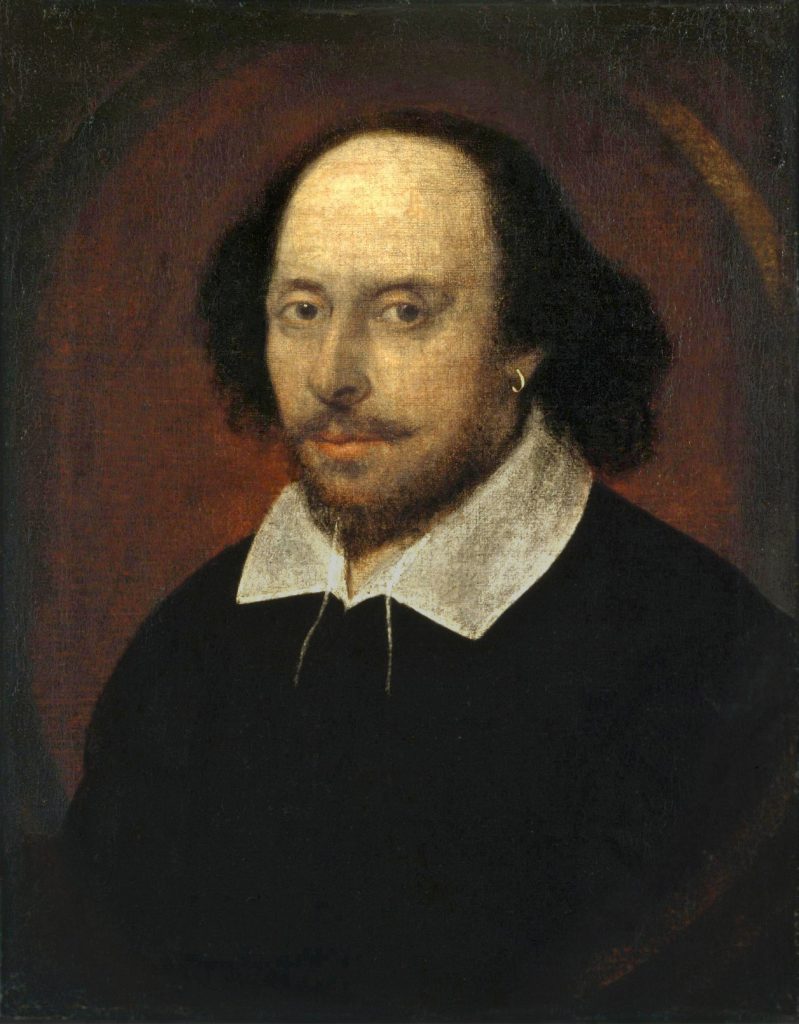
John Taylor (Attributed, Portrait of William Shakespeare, 1610, National Gallery of London, London, UK.
Shakespeare’s writings cover the whole gamut of human experience. From love to hatred, allegiance to betrayal, revenge to redemption, and everything in between, there is something in Shakespeare for just about every mood and emotion. Through Shakespeare’s characters, which manage to be both universal and unique at the same time, the PRBs spoke truths to their audience through story and symbolism.
The earliest of these paintings by Millais is Othello and Desdemona, from 1841-1843.
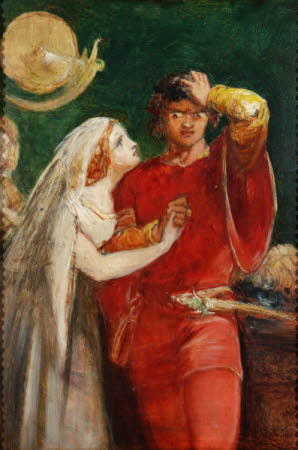
John Everett Millais, Othello and Desdemona, c. 1843, National Trust Collections, Oxfordshire, UK.
Millais was only 14 years old when he finished this oil sketch. On the back of the panel is a letter from Millais, dated June 17th, 1888:
Dear Sir The sketch of Othello and Desdemona is a very, very early performance of yours truly J. Millais.
The tale of Othello is a story of jealousy and its power to blind one to what is good and joyful. At the beginning of the story, Othello is a brave, dashing man who has won the heart of the lovely Desdemona, so much so that they have eloped. The antagonist, Iago, opens the scene by letting the audience know that he is merely pretending to love and follow Othello.
When Iago’s scheme to destroy their marriage by rousing the anger of Desdemona’s father against Othello fails, he proceeds with an even more vicious campaign. He poisons Othello’s heart against Desdemona herself, to the point where his love for her turns to complete hatred and, eventually, violence.
Millais’ sketch captures Othello and Desdemona’s expressions so accurately. Desdemona’s pleading, contrasted with Othello’s disgust, is poignant and meaningful. His use of bright color in the background, and the contrast between the two characters, make a commentary in and of themselves. It’s a very interesting subject matter for a teenager!
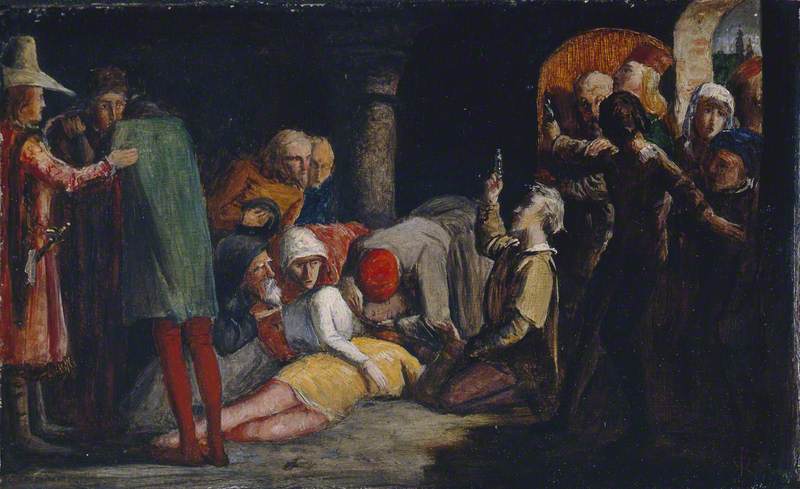
John Everett Millais, The Death of Romeo and Juliet, c. 1848, Manchester Art Gallery, Manchester, UK.
Romeo and Juliet is one of Shakespeare’s best-known works and it needs little summary. The title characters fall in love, but the blood feud between their families prevents them from being together. As the circumstances conspire against them, their planned elopement goes awry. By the end of the play, the lovers are both dead and their families, presumably, are on their way to resolving their differences. But, at what price? A tale of star-crossed lovers and the consequences of an unforgiving heart, it has been adapted countless times and in different time periods and mediums.
“This letter doth make good the Friar’s words,
Their course of love, the tidings of her death;
And here he writes that he did buy a poison
Of a poor ‘pothecary, and therewithal
Came to this vault to die and lie with Juliet
Where be these enemies?—Capulet, Montague,
See what a scourge is laid upon your hate . . .”
Romeo and Juliet, act 5, scene 3.
Millais’ own interpretation tries to get at the core of the pathos of what it would really have been like at the precise moment when the death of the lovers is discovered. Romeo and Juliet, in bright colors, take the center of the composition. To their right, a man holds the vial of poison from which the lovers drank, and everything becomes clear. All emotions unravel, and the viewer is left with a sense of profound sadness.
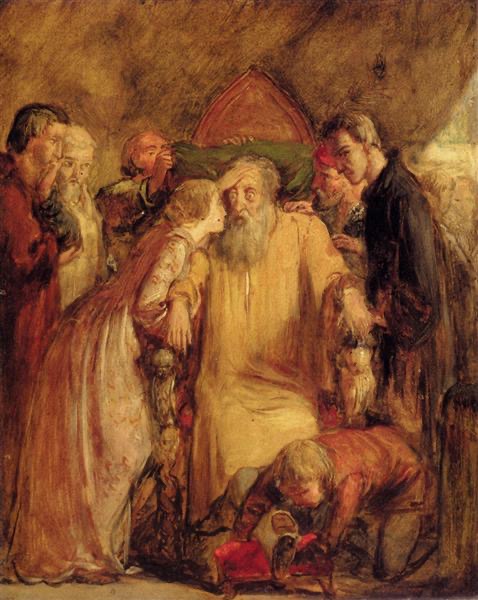
John Everett Millais, Lear and Cordelia, c. 1848, Private Collection. Photograph via Wikiart.
The painting Lear and Cordelia belongs to a private collection, and the date is unclear. However, there seems to be a sheet of paper attached to the backing, dated 10 March 1891, which reads:
The Little sketch of Lear is my work when I was a lad/ … J E Millais.
Scholars think that the rich coloring, and the prominent characterization of the figures, place it in the late 1840s, during a period in which Millais was exploring different historical painting styles. It is interesting that Millais’ friend, Ford Madox Brown, had also begun a painting inspired by this same subject in 1848.
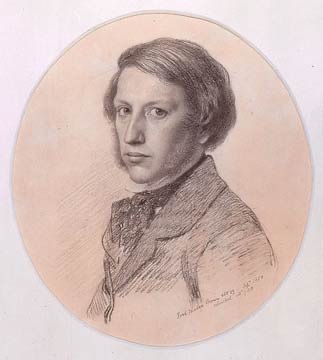
Ford Madox Brown, Self-portrait, 1850. Photograph via FastilyClone, Wikimedia Commons (public domain).
King Lear is an aged king of ancient Britain who plans to divide his kingdom among his three daughters. He tests each one by asking how much they love him. The two older flatter him; the youngest, Cordelia, does not, and for that, she is disowned. The two older daughters eventually turn on Lear, leaving him to wander as a madman.
When Lear’s subject, the Duke of Gloucester, tries to help him, he is punished by having his eyes pulled out. Cordelia, who has married the King of France, comes to Lear’s rescue, but too late. Millais’ painting portrays the moment when Lear’s madness abates, and he recognizes his daughter as they are imprisoned together.
CORDELIA: O, look upon me, sir,
And hold your hand in benediction o’er me…
LEAR: I am a very foolish fond old man,
Four score and upward, not an hour more nor less,
And to deal plainly,
I fear I am not in my perfect mind…
yet I am doubtful, for I am mainly ignorant…
For, as I am a man, I think this lady
To be my child Cordelia.
CORDELIA, [weeping] And so I am; I am.
King Lear, act 4, scene 7.
King Lear pits two opposing forces struggling for dominance. While Edmund (Gloucester’s younger son), and Lear’s two elder daughters represent cruelty and greed, Edgar (Gloucester’s eldest son), Cordelia, and the loyal Duke of Kent stand for kindness, order, and love.
In the end, Edgar cannot save Lear. Both Lear and Cordelia, the daughter who loved him best and stood by him in the end, die together by Edmund’s decree. Edgar comes too late to save the past, but by ridding the land of all wicked influences, he restores the hope for a new future.
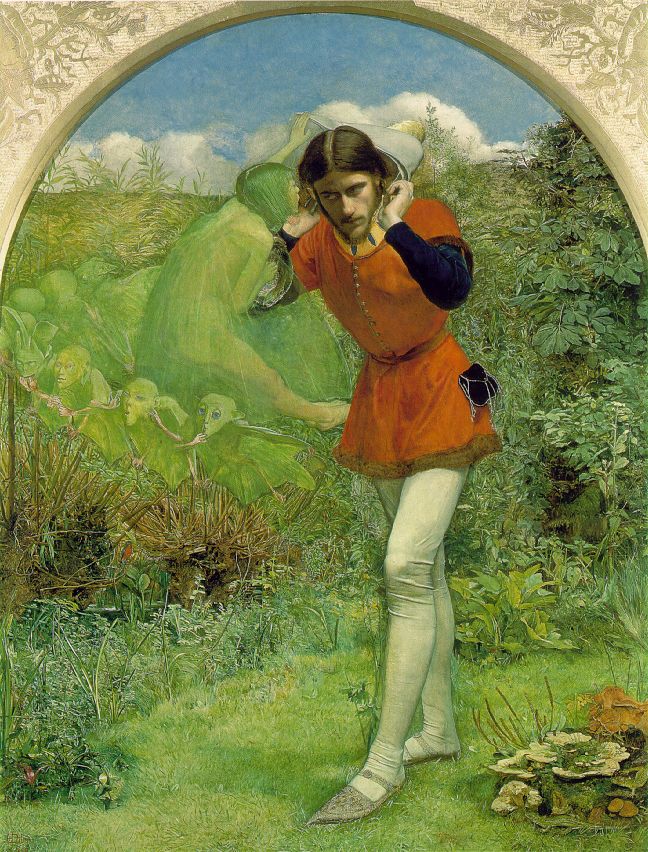
John Everett Millais, Ferdinand and Ariel, 1850, Private Collection. Photograph via Paul Barlow, Wikimedia Commons (public domain).
FERDINAND: …Where should this music be? I’ th’ air, or th’ earth?
It sounds no more; and sure it waits upon
Some god o’ th’ island. Sitting on a bank,
Weeping again the King my father’s wrack,
This music crept by me upon the waters,
Allaying both their fury and my passion
With its sweet air. Thence I have followed it,
Or it hath drawn me rather. But ‘tis gone.
No, it begins again…
The Tempest, act 1, scene 2.
Ferdinand and Ariel was Millais’ first attempt to paint in the plein air style that the PRBs became known for. Millais wrote to his friend and fellow PRB, Holman Hunt, that he had painted a ridiculously elaborate landscape. He also mentioned that, if he were to paint nature as it truly was, it would have taken him a month per weed. This is quite humorous because his landscape is pretty elaborate as it is!
Ferdinand’s face is modeled after another fellow PRB, Frederic George Stephens. The PRBs were very interested in scientific discovery. Millais reflects this inclination through his faithfulness in depicting detail: note the lizards at the bottom right, Ariel itself, and the “bats” in Ariel’s entourage, all camouflaged and blending into the scenery as if they were part of it. It was these figures that put off the original patron who commissioned this piece. He refused to buy it because the bats were too grotesque and different from the standard fairy depictions of the day.
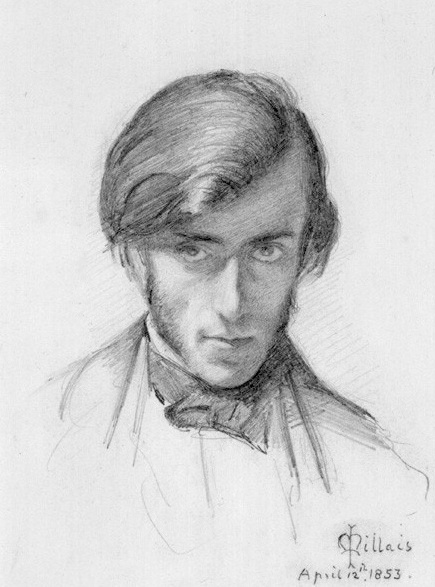
John Everett Millais, Frederic George Stephens, 1853, National Portrait Gallery, London, UK. Photograph via Paul Barlow, Wikimedia Commons (public domain).
The episode portrayed comes from The Tempest, Shakespeare’s story of shipwreck, magic, and forgiveness. In Romeo and Juliet, the feuding parents realize their error too late. But, in The Tempest, Shakespeare gives the lovers a happy ending. The action opens with a storm that shipwrecks Antonio, the Duke of Milan, his friend Alonso, and Alonso’s son, Ferdinand. The storm has been caused by the magical powers of Prospero, the former Duke of Milan, and Antonio’s brother. Prospero has been exiled for 12 years due to Antonio’s coup, and now is ready for revenge.
Prospero lives on a deserted island with his daughter, Miranda, a spirit named Ariel, and the monster, Caliban. He orchestrates all the action of the play, with the help of Ariel and his magic. It is Ariel that leads Ferdinand to Miranda, with whom he falls deeply in love.
Prospero enslaves Ferdinand to test their love. He endeavors to control and subdue all of his enemies until, in the end, when he deems that he has punished them enough, he simply forgives them. Alonso restores Prospero to the dukedom and welcomes Miranda as Ferdinand’s wife.
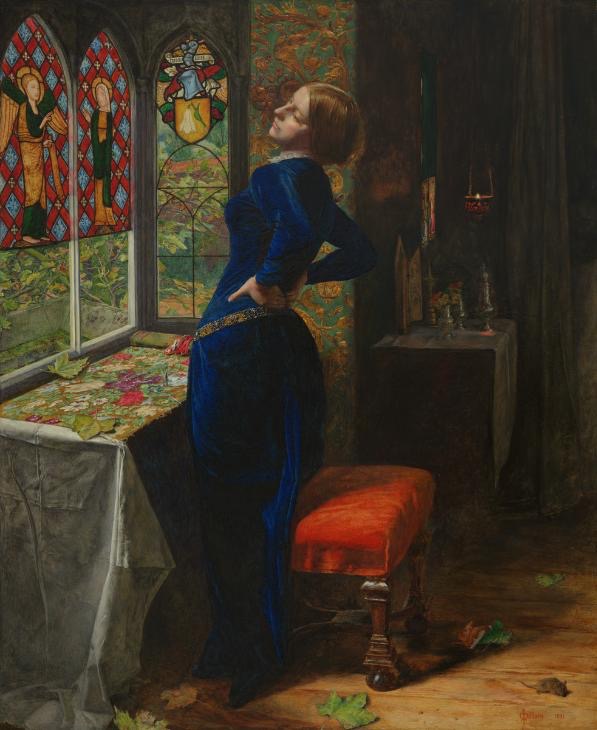
John Everett Millais, Mariana, 1851, The Tate, London, UK.
Mariana is a magnificent example of cross-inspiration. Millais’ painting itself was inspired by a poem of Tennyson’s which was, in turn, inspired by a play of Shakespeare’s which, in turn, takes some of Mariana’s plot line from none other than the Bible.
She only said, ‘My life is dreary,
He cometh not,’ she said;
She said, ‘I am a weary, a weary,
I would that I were dead!’
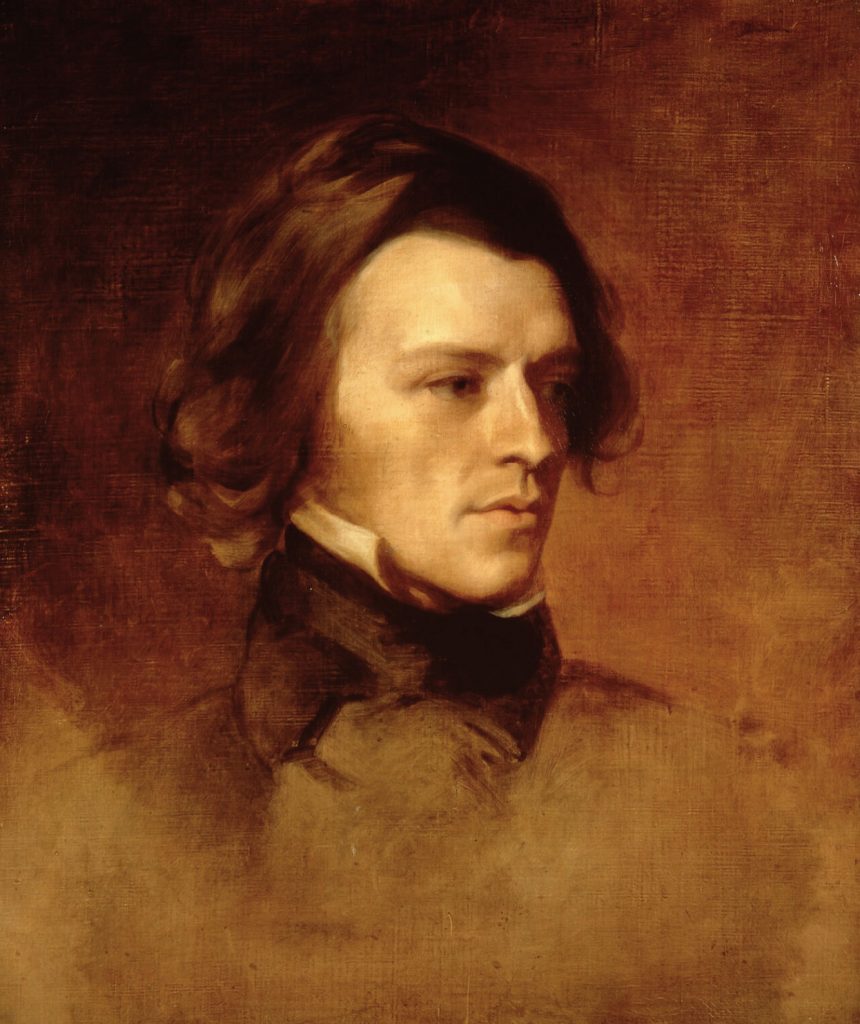
Samuel Laurence, and Sir Edward Burne-Jones, Alfred, Lord Tennyson, c. 1840, National Portrait Gallery, London, UK.
Mariana lives in Shakespeare’s Measure for Measure, though she is not the main character. In fact, we do not hear about her until Act 3.
VINCENTIO, THE DUKE: … Have you not heard speak of Mariana, the sister of Frederick, the great soldier who miscarried at sea? . . .
She should this Angelo have married; was affianc’d to her by oath, and the nuptial appointed; between which time of the contract and limit of the solemnity, her brother Frederick was wracked at sea, having in that perished vessel the dowry of his sister. But mark how heavily this befell to the poor gentlewoman: there she lost a noble and renown’d brother, in his love toward her ever most kind and natural; with him, the portion and sinew of her fortune, her marriage-dowry; with both, her combination-husband, this well-seeming Angelo.
Measure for Measure, act 3, scene 1.
Though to us, modern audiences, it seems ill-judged of Mariana to pine after a man who left her when her dowry failed to materialize, she pines after him nonetheless. What did Millais see in Mariana that inspired this painting? Is Millais’ Mariana the same as Tennyson’s Mariana? There are clues in the painting that depicts longing, yes, but there is more. We see Mariana’s awareness of herself, her unfulfilled desires, but also her strength to go after what she wants.
Mariana puts forward many of the passions of the Pre-Raphaelites: showing the world as it is and, particularly, showing women’s reality, regardless of the viewer’s feelings about it.
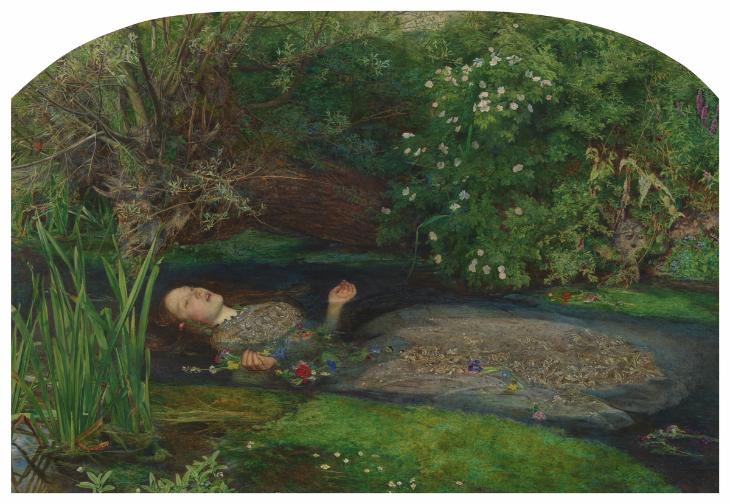
John Everett Millais, Ophelia, 1851-1852, The Tate, London, UK.
Ophelia needs no introduction—she is one of the most popular Pre-Raphaelite works. Arguably, she is one of the most popular British works of the 19th century. In fact, Ophelia was part of the original Henry Tate Gift in 1894, which became the Tate Gallery.
LAERTES: Drowned! O, where?
QUEEN GERTRUDE: There is a willow grows askant the brook,
That shows his hoar leaves in the glassy stream.
Therewith fantastic garlands did she make
Of crow flowers, nettles, daisies, and long purples . . .
There on the pendent boughs her crowned weeds
Clambering to hang, an envious sliver broke,
When down her weedy trophies and herself
Fell in the weeping brook.
Hamlet, act 4, scene 7.
Historically speaking, one of the most striking aspects of this painting is that Millais painted on location. At the time, artists worked outdoors to produce sketches, which they then used as references to finish paintings back in their studios. Millais and his fellow PRBs, however, completed their work outside, which was a highly unusual practice. Millais’ faithfulness to the natural detail was such that it is possible to visit the site where he worked, by the Hogsmill River at Ewell, in Surrey, and recognize it from the painting.

Part of the Hogsmill River where Millais is thought to have painted Ophelia. Photograph via The Tate.
Millais worked on the scene over a period of five months, but he was so faithful to the detail that he painted flowers that bloom at different times of the year next to each other, depending on what the landscape looked like each time he was on location. The flowers were so realistic that, the story goes, a professor teaching botany who could not take his students into the country, took them to see Ophelia instead, since it was just as instructive as nature itself.
Millais’ other obsession was a bit more macabre, but understandable, considering that the PRBs wanted to portray the world truthfully. Millais wanted to see, exactly, what the body would have looked like at the moment of drowning. To study what the fabric would be doing, what the arms, the hair, and the expression would look like, he employed a model—19-year-old Elizabeth Siddal.
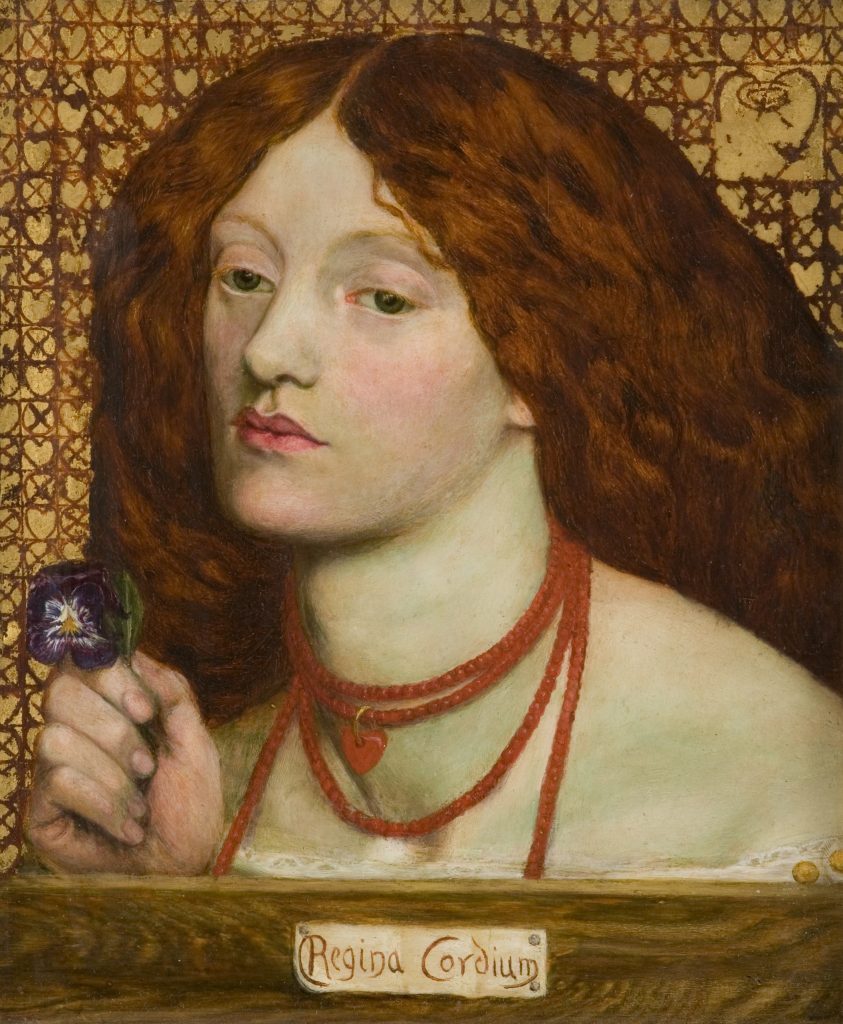
Dante Gabriel Rossetti, Regina Cordium (Marriage Portrait of Elizabeth Siddal), 1860, Johannesburg Art Gallery, Johannesburg, South Africa. Photograph via Micione, Wikimedia Commons (public domain).
Siddal very famously posed for Millais for five months in a bath full of water. Millais tried to keep the water warm by placing oil lamps underneath the bathtub. On one occasion, however, he was so focused on his painting that he did not notice the lamps had gone out. Poor Elizabeth sat in the cold water for hours, to the point that she became ill!
In the death of Ophelia, Millais portrays the inescapable reality of corruption. The world is a place where beauty and decay, strength and fragility, life and death, purity and corruption, exist endlessly intertwined. Maybe it is because we have to live and grapple with this reality ourselves that Ophelia still resonates so strongly with viewers today.
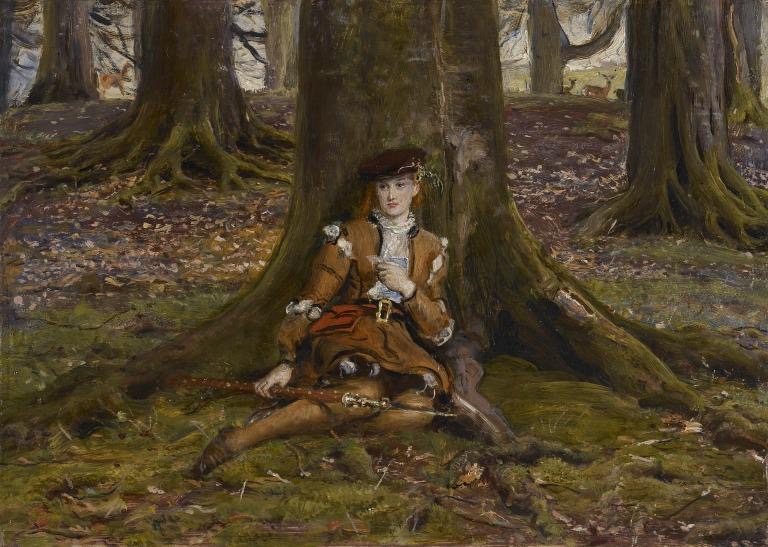
John Everett Millais, Rosalind in the Forest, c. 1867-1868, National Museums Liverpool, Liverpool, UK.
If Shakespeare had been alive today, and he was a mangaka or an anime developer, his offering would have been As You Like It. The play is full of all the elements that we appreciate in the genre—princesses, charming sidekicks, love, betrayal, cross-dressing, exile, shepherds, courtiers, brothers at war . . .
Thanks to a label on the back, scholars believe that this painting is a sketch and a small version of a larger work shown at the Royal Academy in 1868. The exhibition painting seems to be untraced, but there is a print of an engraving on the Victoria & Albert Museum’s website.
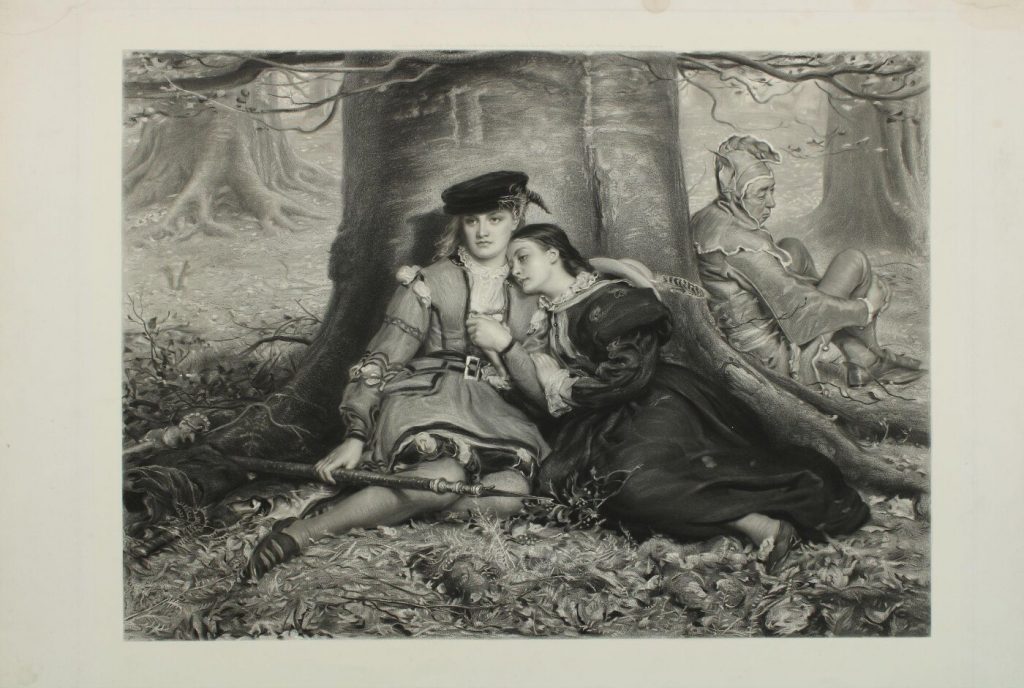
William Henry Simmons (Engraver) and John Everett Millais (Artist), Rosalind and Celia, 1870, Victoria & Albert Museum, London, UK.
Rosalind is the daughter of an exiled Duke. Her best friend in the world is her cousin, Celia, who happens to be the daughter of Duke Junior, the man who overthrew her father. Eventually, Rosalind and Celia decide to leave the protection of Duke Junior and join Rosalind’s father in the forest.
Meanwhile, Orlando and his brother Oliver are at odds regarding their father’s fortune and the control of Orlando’s life and assets. Of course, Orlando also flees to the forest of Arden, seeking refuge. There, he reconnects with Rosalind, with whom he has fallen deeply in love. The only problem—Rosalind is now disguised as a man, Ganymede, and it is in this role that Orlando knows, and courts her, for most of the play. It would not have escaped the original audiences, as it does not escape us today, that the 16th-century actor playing Rosalind would have been a male, following the practice of the time. In other words, a boy playing a girl playing a boy pretending to be a girl.
As with all of Shakespeare’s comedies, all is eventually set to rights. The lovers—both old and new—are reunited, titles are restored, and the forest is once again peacefully left undisturbed.
Millais’ decision to show Rosalind wearing the contemporary-style dress rather than the costume for the time in which the play was set, was in keeping with the PRB’s desire to speak to their audiences with the truth. The play’s themes about the nature of gender and desire, femininity and strength, primogeniture and conflict between brothers, or between children and their parents, are all made more poignant when taken out of their original context and brought into the present.
Enter Rosalind as Ganymede, Celia as Aliena, and Clown, alias Touchstone.
ROS. (As GAN.)
O Jupiter, how weary are my spirits!
TOUCH.
I care not for my spirits, if my legs were not weary.
ROS. (As GAN.)
I could find in my heart to disgrace my man’s apparel and to cry like a woman; but I must comfort the weaker vessel, as doublet and hose ought to show itself courageous to petticoat; therefore courage, good Aliena.
CEL. (As ALI.)
I pray you bear with me, I cannot go no further.
TOUCH.
For my part, I had rather bear with you than bear you. Yet I should bear no cross if I did bear you, for I think you have no money in your purse.
ROS. (As GAN.)
Well, this is the forest of Arden.
As You Like It, Act 2 Scene 4.
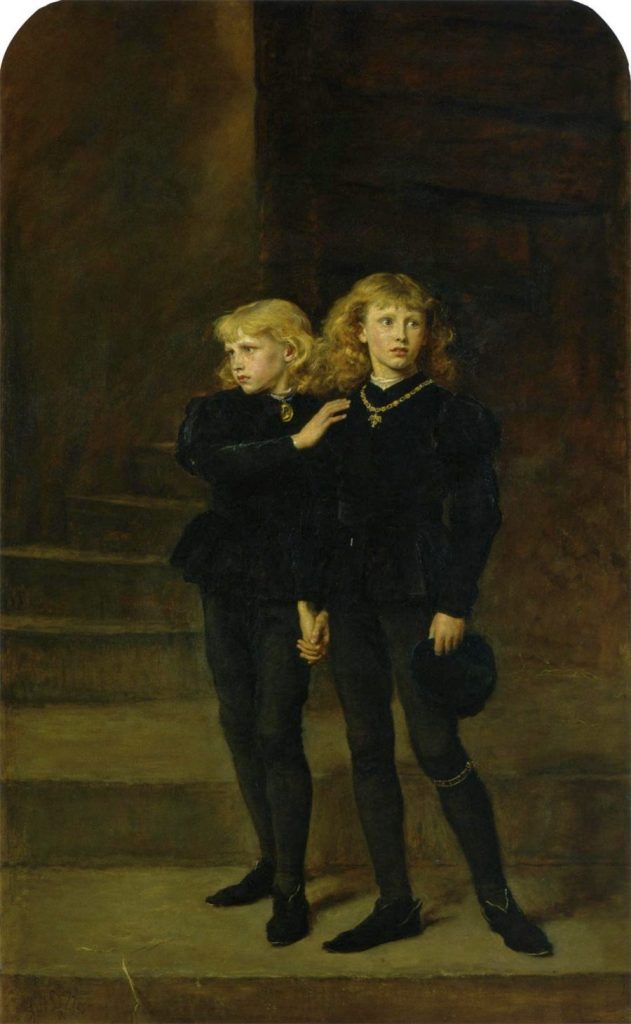
John Everett Millais, The Princes in the Tower, 1878, Royal Holloway Collection, London, UK. Photograph by Alonso de Mendoza, via Wikimedia Commons (public domain).
The mystery of what really happened to the princes in the tower, Edward, Prince of Wales, and his young brother Richard, Duke of York, has been the source of grief and speculation for centuries.
Shakespeare gives us his opinion of what happened in the history play, Richard III. The political situation during this time was fraught with uncertainties, and Shakespeare gives us a good rundown of the whole affair. In the middle of the Wars of the Roses, the Yorkists took over government in the form of King Edward IV, the heir to Richard Plantagenet, 3rd Duke of York. Yes, there are lots of Richards and Edwards in this story, and it is quite a task to keep everybody straight.
In a nutshell, the Wars of the Roses were a series of civil wars in England, fought between the York and Lancaster factions between 1455 and 1487. Edward IV defeated the Lancastrian armies and, after deposing King Henry VI (events which Shakespeare also depicts in his series of Henry VI plays), he won the English crown. He had more difficulty keeping it, however.
In a romantic, though probably not a very smart move, Edward married Elizabeth Woodville. This marriage to one of his subjects, a minor aristocrat who agreed to marry him in secret, alienated many powerful men of the court. The unfortunate young princes in the tower were born from this union—Edward (who would have been the fifth of that title, had he become king), and little Richard of Shrewsbury, Duke of York.
The problem was that Edward IV’s younger brother, Richard, Duke of Gloucester (yes, another Richard), seemed to have designs on the throne as well. When Edward IV died of illness, Richard managed to get himself named Lord Protector for his brother’s eldest son and successor, the 12-year-old Edward V.
Richard Gloucester went on preparing for a coronation that never took place. Through a series of events, the marriage of the young king’s parents was declared bigamous, making the king illegitimate and, therefore, ineligible to accede to the throne. Richard, now renamed Richard III, was declared the rightful king, while young Edward and his brother were never heard from again.
RICHARD, [to Prince]
My lord, will ‘t please you pass along?
Myself and my good cousin Buckingham
Will to your mother, to entreat of her
To meet you at the Tower and welcome you.
YORK, [to Prince]
What, will you go unto the Tower, my lord?
PRINCE
My Lord Protector needs will have it so.
YORK
I shall not sleep in quiet at the Tower.
RICHARD
Why, what should you fear?
YORK
Marry, my uncle Clarence’ angry ghost.
My grandma told me he was murdered there.
PRINCE
I fear no uncles dead.
RICHARD
Nor none that live, I hope.
Richard III, act 3, scene 1.
Theories abound as to what happened to the young boys. Their murder was never proven and, to this day, nobody knows whether they were able to escape and continue living their lives under assumed identities, or whether they were cruelly murdered. And, if the latter, nobody knows for sure whether it was Richard III who murdered them, or another unscrupulous soul likely to benefit from the turn of events.
If you are still with us after this long history lesson, this painting has an interesting history as well. Millais’ son, John Guille Millais, tells that his father thought of the subject as soon as he saw the two boys who posed as models. It seems that Millais had a gift for suiting models to subjects. Millais’ perfect models had to go with the perfect tower setting, and this came from the Perthshire village of Birnam. John’s account of the process is very enlightening about the way Millais worked.
Not being quite satisfied that the background was sufficiently like the spot in “The Bloody Tower,” where the boys are supposed to have been murdered, he sent me on three successive days to make pencil sketches of the interior; and finding from them that he had got the steps too small, and the staircase going the wrong way, he went and made drawings himself. Then, throwing aside the work he had already done, he started the picture again on a new and larger canvas showing the exact surroundings of the place where the bodies of the murdered princes were found.
The Life and Letters of John Everett Millais.
Today we know that the bodies have never been found, but for centuries historians thought that some bones found under the stairs did, indeed, belong to the princes. Just like he had done with Ophelia, Millais had to have an accurate setting, and that is why he has the boys holding hands in a dark corridor, next to the stairs. Just like with Ophelia, or Mariana, or Othello, or Ferdinand, or any of his other Shakespearean paintings, Millais places his characters at a very important moment of realization, a characteristic moment where things are ready to turn around in their story.
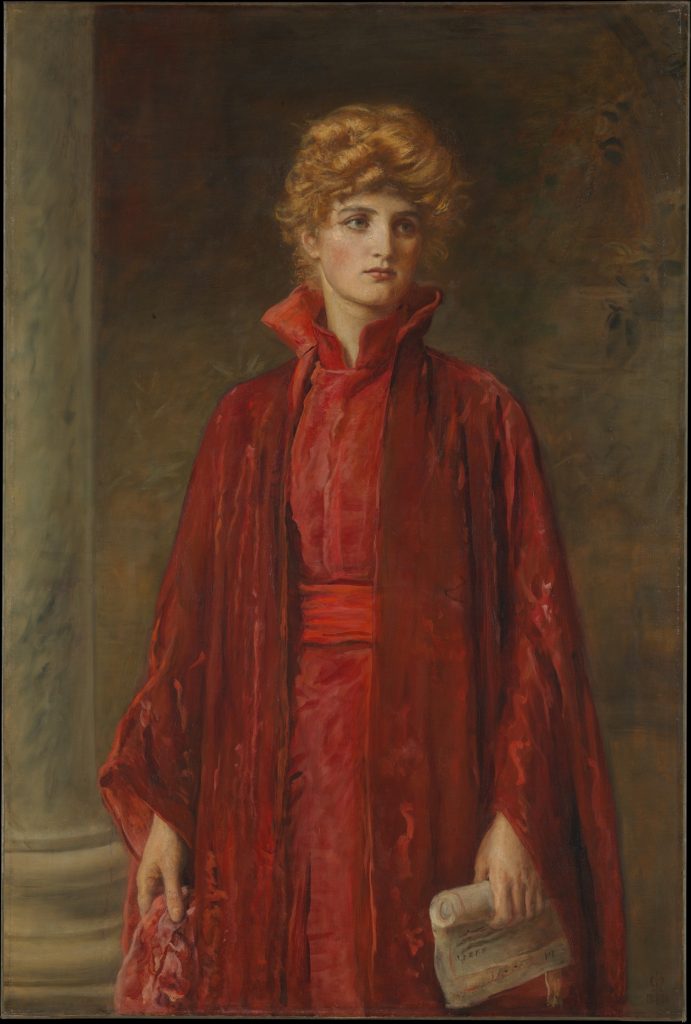
John Everett Millais, Portia, 1886, The Met, New York, NY, USA.
Shylock may be the most memorable character in The Merchant of Venice, but it is Portia who will forever steal the show. In the play, Shakespeare gives us a girl who has been so sheltered by her father that he even has set up a contest so that, after his death, she can find a suitable husband. Portia’s stars smile on her when Bassanio, the young Venetian she loves, wins her hand.
Her good luck does not last too long, however. Bassanio had incurred a great debt to court Portia. Antonio, Bassanio’s benefactor, is in turn indebted to Shylock for a great part of his fortune. When Shylock demands his payment, both Bassanio and Antonio are subject by law to pay the agreed-upon price. And that price is, for Antonio, a pound of flesh. Yes, you read that right: A pound of flesh. Antonio’s flesh.
Bassanio and Antonio travel to Venice to appear at the court. Unbeknownst to Bassanio, Portia follows shortly after. Disguised as a lawyer, Portia’s wits and her knowledge of the law defeat Shylock, and secure freedom for her husband and his dear friend.
Millais’ Portia had a bit of a mystery to her, as well. For many years, the model was misidentified as Ellen Terry because of the fabulous red dress that Portia is wearing in the painting. Terry played Portia in The Merchant of Venice over a thousand times, wearing that very costume. It was later discovered that she had only loaned Millais the dress. John Guille Millais remembered his father’s search for a model.
Millais had trouble managing his schedule, and he often overbooked appointments. This led to John scheduling multiple potential models to arrive at the same time. John recalls that the model finally selected, Kate Dolan, was one that he had booked.
DUKE: This letter from Bellario doth commend
A young and learned doctor to our court.
Where is he?
NERISSA, [as Clerk] He attendeth here hard by
To know your answer whether you’ll admit him.
DUKE: With all my heart. —Some three or four of you
Go give him courteous conduct to this place . . .
And here I take it is the doctor come.—
Give me your hand. Come you from old Bellario?
PORTIA, [as Balthazar] I did, my lord.
The Merchant of Venice, Act 4, scene 1.
Portia shows that where there’s a will, there’s a way, and that it will never do to lose hope—things may turn at the most desperate moment.
From Othello to Portia, we have come full circle to the last of Millais’ Nine Shakespeare paintings. Through his treatment of such strong literary characters, Millais reconnected his viewers with mirrors that represented subjects that mattered. Shakespeare’s people spoke up about concerns that affect humanity even today. Through the plays and Millais’ recreations of them, we encounter themes of love, death, fear, rejection, hope, despair, duty, jealousy, cruelty, fairness, justice, prejudice, and kindness. These themes deeply resonated with Millais’ 19th-century audience.
But, are these not things that we worry about constantly too? It is beautiful to see that humankind, for all its progress, is still, essentially, the same. We feel just as strongly as our ancestors did, and as our descendants will do after us. And, in some ways, we have just as much to learn. We are all connected, in one way or another. Bringing light to that connection to make us feel, to make us do something with that knowledge—that is what art is all about.
DailyArt Magazine needs your support. Every contribution, however big or small, is very valuable for our future. Thanks to it, we will be able to sustain and grow the Magazine. Thank you for your help!